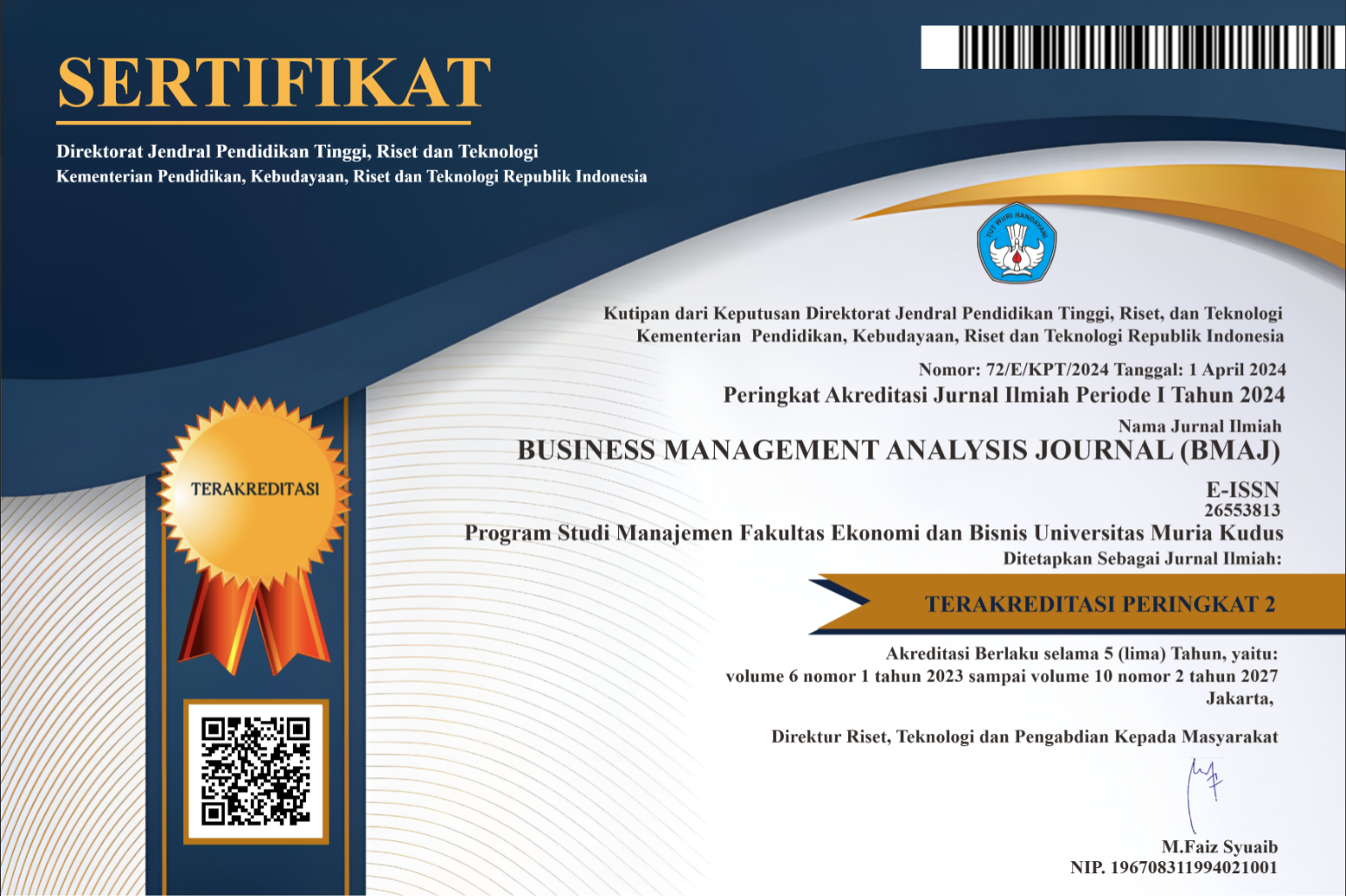Apakah Sebuah Iklan Dapat Mempengaruhi Konsumen Berlangganan terhadap Restoran Halal?
Abstract
The investigation of consumer’s perception was widely comprehensive. Many advertisements are represented as campaign of enterprises to promote their company. This is depending on the image of restaurant to shape consumer’s perception towards halal restaurant. This study was investigating the consumer’s perception towards halal restaurant in Bogor. The investigation was accomplished using quantitative method with 100 respondents who live in Bogor. From the factor analysis result was identified by small components which able to be used as clarification for a number of interrelated variables among the advertisement, consumers attitude and subscribing halal restaurant. Analysis result was found that the consumer’s attitude does not have major mediating effect towards the relationship between advertisement to be the customer of halal restaurant.
Investigasi persepsi konsumen sangat luas. Banyak iklan diwakili sebagai kampanye perusahaan untuk mempromosikan perusahaan mereka. Ini tergantung pada citra restoran untuk membuat persepsi konsumen terhadap restoran halal. Studi ini menyelidiki persepsi konsumen terhadap restoran halal di Bogor. Penyelidikan dilakukan dengan metode kuantitatif dengan 100 responden berdasarkan tempat tinggal mereka di Bogor. Hasil analisis dalam penelitian ini sangat bagus. Dari hasil analisis faktor, diidentifikasi komponen kecil yang dapat digunakan sebagai klarifikasi untuk sejumlah variabel yang saling terkait antara iklan, sikap konsumen dan berlangganan restoran halal. Hasil analisis mendapatkan bahwa sikap konsumen tidak memberikan efek mediasi yang besar pada hubungan periklanan dengan berlangganan restoran halal.
Keywords
Full Text:
PDF (Bahasa Indonesia)References
Adiningsih, K. P. (2012). Analisis Kepuasan dan Loyalitas Konsumen Restoran Nasi Bebek
Ginyo di Jakarta. Master’s thesis. Institut Pertanian Bogor.
Akim, A. K., & N. Purmana (2019). The Shifting of halal Certification System in Indonesia:
From Society-Centric To State-Centric. MIMBAR: Jurnal Sosial dan Pembangunan, 35(1),
-126.
Akpan, C., & Nwankpa, N. (2015). Influence of Facebook Advertisement on the Buying
Behaviour of Students of a Nigerian University. International Journal of Humanities and
Social Science, 5(7), 135-148.
Alam, S., & Sayuti, N. (2011). Applying the Theory of Planned Behavior (TPB) in halal Food
Purchasing. International Journal of Commerce and Management, 21(1), 8-20.
Barrow, P. (1990). Does Your Advertising Direct or Intrude? Canadian Manager 15, 26-27.
Bohari, A. M., Cheng, W. H., & Fuad, N. W. (2013) An Analysis on The Competitiveness of
halal Food Industry in Malaysia: An Approach of SWOT and ICT Strategy. Malaysia
Journal of Society and Space, 9(1), 1-11.
Cappo J (2003). The Future of Advertising: New Media, New Clients, New Consumers in the
Post-Television Age. New York: McGraw Hill.
Cook G (2001). The discourse of advertising, (Ed.2). New York: Routledge.
Du Plessis, F. Bothma, N, Jordaan Y., & Van Heerden, N. (2003). Integrated marketing
communication. Claremont: New Africa Books.
Dyck, J., Woolverton, A. E., & Fahwani, Y. R. (2012). Indonesia’s Modern Food Retail Sector:
Interaction with Changing Food Consumption and Trade Patterns. Economic Information
Bulletin Number 97: Department of Agriculture,Economic Research Service.
Fernandez, K. V. (1995). Information Processing in Directional Media: The Effectiveness of
Selected Advertising Executional Cues In the Yellow Pages. Dissertation submitted to the
School of Business and the Faculty of the Graduate School of the University of Kansas.
Fernandez, K. V., & Rosen, D. L. (2000). The Effectiveness of Information and Color in Yellow
Pages Advertising. Journal Of Advertising, 29(2), 61-73.
Fishbein, M. & Ajzen, I. (1975). Belief, Attitude, Intention , and Behaviour: An Introduction to
Theory and Research. MA: Addison Wesley.
Friman J. (2010). Consumer attitudes toward mobile advertising (Master Thesis). AALTO
University School of Economics, Department of Marketing and Management
https://aaltodoc.aalto.fi/bitstream/handle/123456789/469/hse_ethesis_12337.pdf?sequence
=1
Gerasymenko, A. (2012). Informative Advertising: A Market Information Provider or A Seed of
Market Power. Journal of Ecoforum, 1(1), 58-63.
Hackley, C. (2010). Advertising & Promotion: An Integrated Marketing Communications
Approach, (Chap.1). London: Sage.
Haghirian, P. & Madlberger, M. (2005). Consumer Attitude Toward Advertising Via Mobile
Devices - An Empirical Investigation Among Austrian Users. Proceedings ECIS (European
Conference of Information Systems), Regensburg, Germany.
Hardey, M. (2015). Viewpoint: New Visions: Capturing Digital Data and Market
Research. International Journal of Market Research, 54(2), 159-161. doi:10.2501/IJMR54-2-159-161
Hussein, A., Ismail, T., & Hapsari R. (2015). The Formation of Brand Loyalty in Indonesian.
European Journal of Tourism, Hospitality and Recreation, 6(2), 67-98.
Jaworski, B. J. & Maclnnis, D. J. (1989). Information Processing form Advertisements : toward
an Integrative Framework. Journal of Marketing.1-23.
Kaasinen, E. (2003). User needs for location-aware mobile services. Personal and Ubiquitous
Computing, 7, 70-79.
Ling, K.C., Piew, T.H., & Chai, L.T. (2010). The Determinants of Consumers’ Attitude Towards
Advertising. Canadian Social, 6(4), 114-126.
Lohse, G. L., & Rosen, D. (2001). Signaling Quality and Credibility in Yellow Pages
Advertising: The Influence of Color and Graphics on Choice, Journal of Advertising,
(2),73-85.
Nunally, J.C. (1978). Psychometric Theory. New York: McGraw-Hill
Olufayo, T. O. (2012). Effect of Advertising on The Patronage of A New Product. International
Journal of Humanities and Social Science, 2(17), 217-225.
Ramaprasad, J., & Thurwanger, M. L. (1998). South Asian Students Attitudes Toward and
Beliefs About Advertising: Measuring Across Cultures. Paper presented at the AEJMC
Annual Conference on International Communication Division, Baltimore, MD.
Rizki, N. W. (2007). Pandangan halal Konsumen Ibu Rumah Tangga Terhadap Label halal
pada Produk pangan di Kota Tangerang. Institut Pertanian Bogor.
Rosenberg, J. M. (1995). Dictionary of Marketing and Advertising. John Wiley & Sons, Inc.
Setiadi, N J. (2003). Perilaku Konsumen: Konsep dan Implikasi Untuk Strategi dan Penelitian
Pemasaran. Jakarta: Kencana Media.
Verstraten, R. (2015). The Effect of Advertising Credibility: Could It Change Consumers’
Attitude and Purchase Intentions?. Master Thesis Economics & Business. 1-70.
Wright, T (2014). Indonesia Food Service - Hotel Restaurant Institutional Food Service - HRI
Report 2014. USA Foregin Agricultural Service.
Zyman S, Brott A (2002). The End of Advertising As We Know It. New Jersey: John Wiley
DOI: https://doi.org/10.24176/bmaj.v3i2.5359
Refbacks
- There are currently no refbacks.
Copyright (c) 2020 Business Management Analysis Journal (BMAJ)
View My Stats
Member of:
Indexed by:
Business Management Analysis Journal (BMAJ) is licensed under a Creative Commons Attribution-ShareAlike 4.0 International License.
Dedicated to:









